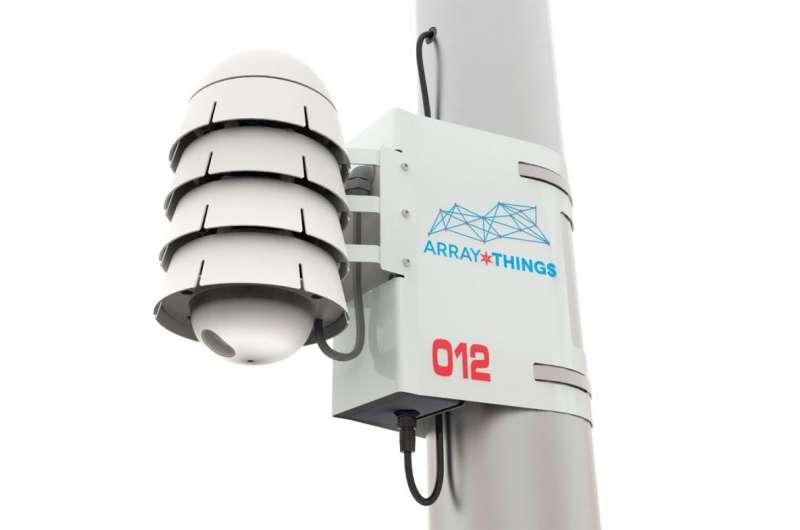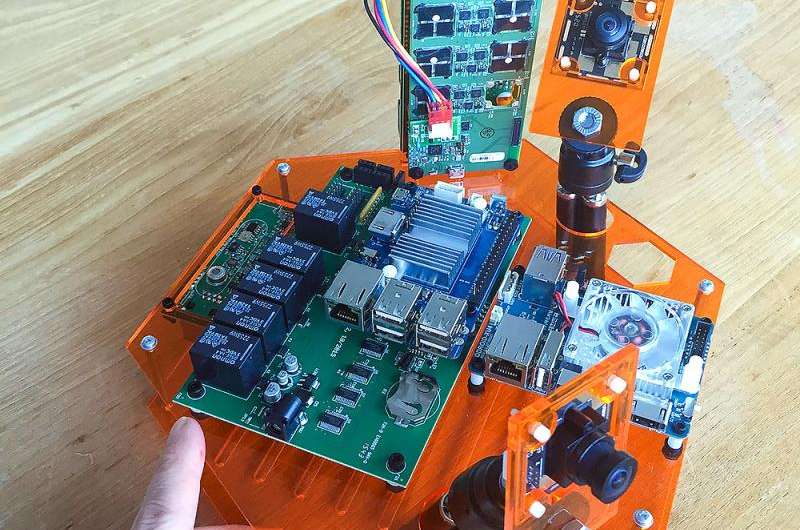Big data project aims to make breathing easier

Heavy city traffic contributes significantly to air pollution and health problems such as asthma, but UT Dallas researchers think another kind of traffic—data traffic—might help citizens better cope with pollution.
"Online maps are accessed millions of times daily by people using computers and mobile devices to find the shortest or least congested route to their destination," said Dr. David Lary, associate professor of physics at UT Dallas. "But suppose you have asthma, or want to take a newborn out for an impromptu walk and you're looking for the least polluted route? We think we can help with that."
Supported by a grant from the National Science Foundation, Lary leads a pilot project called Geolocated Allergen Sensing Platform, or GASP, that will deploy a network of new, advanced sensors to detect asthma-aggravating particulate matter and pollen in metropolitan Chattanooga, Tennessee. The sensors also will gather air-quality data such as location, temperature, pressure, humidity and levels of six other pollutants.
Over the next year, the GASP project will deploy eight advanced sensors on lampposts in Chattanooga. Ten more will be at schools in the Dallas area, under the sponsorship of Earth Day Texas. In addition, several sensors will be set up on the UT Dallas campus.

Chattanooga was chosen to pilot the system in part because it consistently places in the top 25 in the Asthma and Allergy Foundation of America's list of most challenging places to live with seasonal allergies.
Ultra-High-Speed Computer Network
A key component of the project will be the connection of the sensors to an ultra-high-speed computer network, allowing vast amounts of data to be gathered and transmitted in real time.
"Long term, we'd like to combine this 'big data' approach with a visualization tool to support an open access dissemination platform similar to Google's Street View, but focused on mapping pollution," Lary said.
"In addition to aiding consumers, municipalities might use the information to identify where and when the most troublesome air quality arises, and develop remediation efforts based on the data," he said. "Ultimately, we want to determine whether real-time allergen and pollution collection and analysis on very fine geographic scales—the scale of a city block or less—can improve health and wellness."
According to a 2014 report by the World Health Organization, around 7 million people died in 2012 as a result of air pollution exposure. More than 50 million Americans have allergic diseases, including asthma and allergic rhinitis, which are aggravated by airborne pollen and fungal spores as well as pollution.
The U.S. Environmental Protection Agency sets national ambient air-quality standards, and automated monitoring stations are set up across the country to continuously track the levels of potentially dangerous pollutants. Most large cities and metropolitan areas like Dallas-Fort Worth, have such stations scattered throughout their geographical region, with online sites reporting the data hourly.
While the type of instruments currently in place to make these measurements provide helpful information, they have limitations, Lary said.
"Not only are existing instruments bulky, they also are expensive, around $100,000 to set one up," he said. "In addition, they are widely scattered, with only a few sensors in the D-FW area and a minimum spacing of 33 kilometers. Ideally, to accurately characterize the spatial distribution of pollutants, we should be making measurements every half a kilometer or less."
Detecting Particulates Smaller than a Grain of Sand
The new sensors use lasers to "count" airborne particulates and determine their size as they cross the laser light's path. The devices can detect particulates ranging from 1 to about 40 microns, including those designated PM2.5, which are 2.5 microns or less. By comparison, a grain of sand is about 50 microns. Pollen grains range from about 6 to 100 microns, with most airborne pollen in the range of 15 to 40 microns.
"Cities that have pollen-sampling stations typically have only one station," said Dr. Estelle Levetin, professor and chair of biology at the University of Tulsa, who is an expert on aerobiology and a partner on the project. "In fact, there are many cities, both large and small, with no pollen-monitoring stations. This technology will add to our knowledge of airborne pollen levels and how levels vary within a city, and may help individuals with pollen allergies avoid areas of a city with higher pollen concentration."
Though they are tiny, PM2.5 particles—which are present in vehicle exhaust, tobacco smoke and other sources—are especially dangerous to human health. Because they are fine enough to be breathed deep into the lungs, these pollutants can aggravate asthma and other respiratory conditions, and contribute to premature death.
"With these sensors you can get very fine spatial variability," Lary said. "I've tested them in my house, and during the day, you can see large variation in the amount of particulates in the air, even within one room.
"In a city, that level of spatial sensitivity can tell you from one block to the next the location of the heaviest amounts of potentially dangerous pollutants."
Real-Time Reporting
A key component of the GASP project is the utilization of an ultra-high-speed computer network that will accommodate large data sets and make real-time reporting possible. UT Dallas and its home city of Richardson last year joined a growing group of communities that are members of US Ignite, a nonprofit organization that fosters the development of projects that use ultra-high-speed computer networks to spur innovation for the benefit of society.
Chattanooga is also a US Ignite member community. Lary's group is coordinating the GASP project with the Enterprise Center, a public-private partnership in Chattanooga that supports the development of applications and research projects to leverage that city's digital capabilities to improve quality of life.
"Collecting and streaming this amount of data requires bandwidth, and our partnership with US Ignite will facilitate this and hopefully many other projects," Lary said. "The combined use of all these technologies—big data, remote sensing, network connectivity, machine learning, the so-called Internet of Things—it's all very up-and-coming, and it's an approach that has tremendous potential to have a massive societal impact."
Provided by University of Texas at Dallas

















